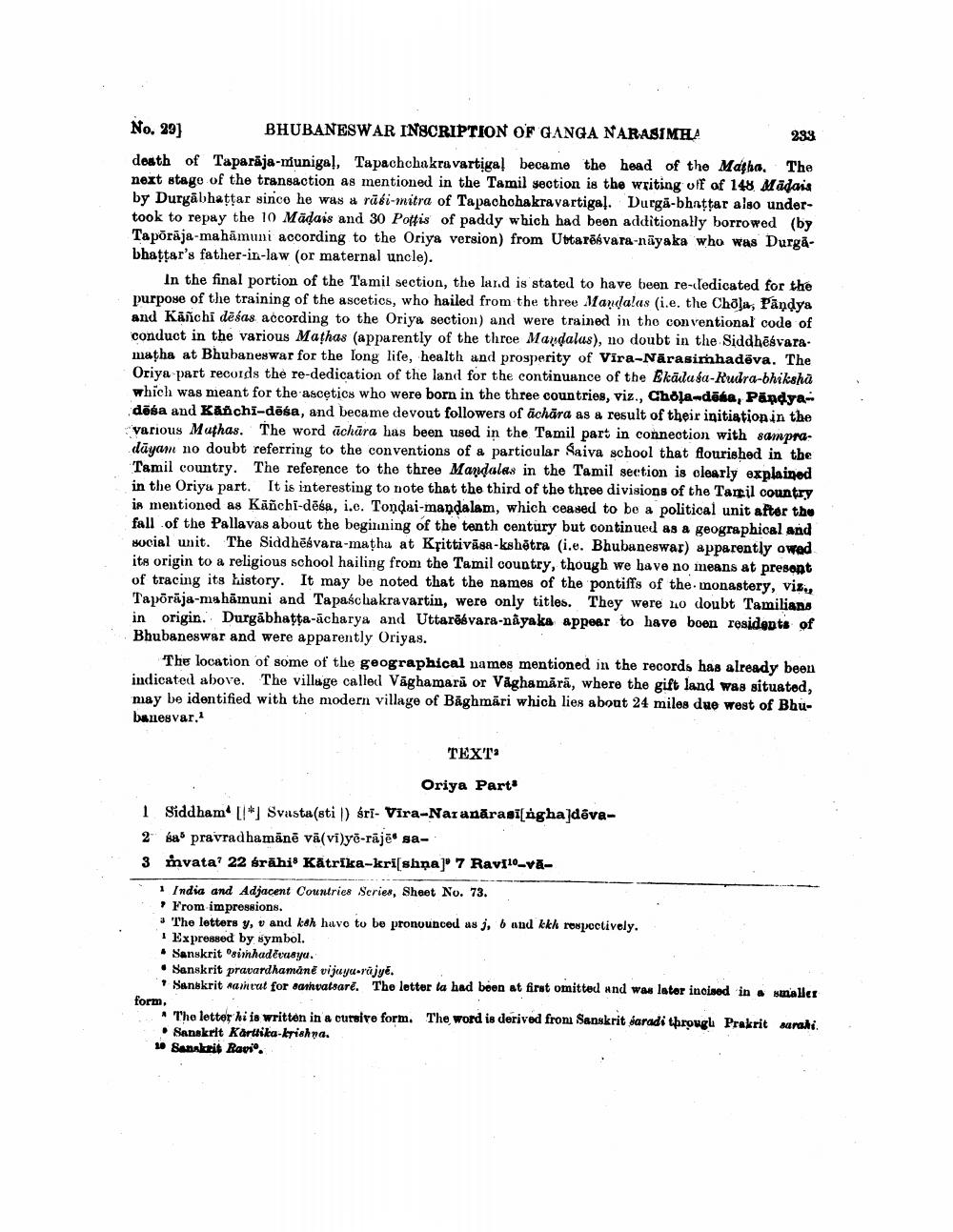________________
233
No. 29]
BHUBANESWAR INSCRIPTION OF GANGA NARASIMHA
death of Taparaja-munigal, Tapachchakravartiga! became the head of the Matha. The next stage of the transaction as mentioned in the Tamil section is the writing off of 148 Madais by Durgabhaṭṭar since he was a rusi-mitra of Tapachchakravartigal. Durga-bhaṭṭar also undertook to repay the 10 Madais and 30 Pottis of paddy which had been additionally borrowed (by Tapōraja-mahamuni according to the Oriya version) from Uttaresvara-nayaka who was Durgabhaṭṭar's father-in-law (or maternal uncle).
In the final portion of the Tamil section, the land is stated to have been re-dedicated for the purpose of the training of the ascetics, who hailed from the three Mandalas (i.e. the Chōla, Pandya and Kanchi desas according to the Oriya section) and were trained in the conventional code of conduct in the various Mathas (apparently of the three Mandalas), no doubt in the Siddhēsvaramatha at Bhubaneswar for the long life, health and prosperity of Vira-Narasimhadeva. The Oriya part records the re-dedication of the land for the continuance of the Ekadusa-Rudra-bhiksha which was meant for the ascetics who were born in the three countries, viz., Chola-desa, Pandyadesa and Kanchi-desa, and became devout followers of achara as a result of their initiation in the various Mathas. The word uchura has been used in the Tamil part in connection with sampradayam no doubt referring to the conventions of a particular Saiva school that flourished in the Tamil country. The reference to the three Mandalas in the Tamil section is clearly explained in the Oriya part. It is interesting to note that the third of the three divisions of the Tamil country is mentioned as Kañchi-desa, i.c. Tondai-mandalam, which ceased to be a political unit after the fall of the Pallavas about the beginning of the tenth century but continued as a geographical and social unit. The Siddhesvara-matha at Krittiväsa-kshetra (i.e. Bhubaneswar) apparently owed its origin to a religious school hailing from the Tamil country, though we have no means at present of tracing its history. It may be noted that the names of the pontiffs of the monastery, viz., Tapōraja-mahamuni and Tapaśchakravartin, were only titles. They were no doubt Tamilians in origin. Durgabhaṭṭa-acharya and Uttareévara-nayaka appear to have been residents of Bhubaneswar and were apparently Oriyas.
The location of some of the geographical names mentioned in the records has already been indicated above. The village called Vaghamara or Vaghamärä, where the gift land was situated, may be identified with the modern village of Baghmäri which lies about 24 miles due west of Bhubanesvar.1
TEXT
Oriya Part
1 Siddham [*] Svasta(sti |) śrī- Vira-Naranarasī[ngha]dēva
2 sa pravradhamānē vā(vi)yē-rājē sa
3 mvata' 22 śrāhi Kätrika-krishna] 7 Ravi10-va
1 India and Adjacent Countries Series, Sheet No. 73.
From impressions.
a The letters y, v and keh have to be pronounced as j, 6 and kkk respectively.
1 Expressed by symbol.
Sanskrit "simhadevasya.
• Sanskrit pravardhamane vijaya-rajye.
Sanskrit saivat for samvatsare. The letter ta had been at first omitted and was later incised in a smaller
form,
The letter hi is written in a cursive form. The word is derived from Sanskrit saradi through Prakrit sarahi. ⚫ Sanskrit Kärttika-krishna.
10 Sanskrit Ravi.




